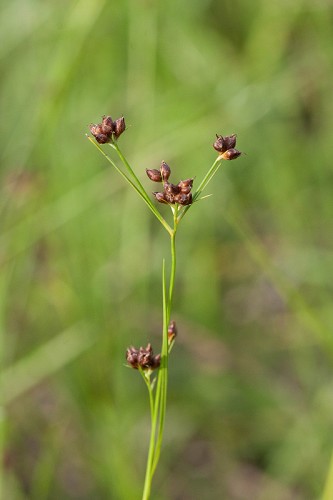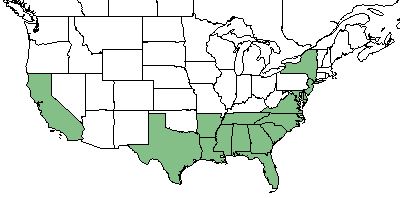Difference between revisions of "Rhynchospora globularis"
Rwagner914 (talk | contribs) (Created page with "{{subst:Template:PlantName}}") |
HaleighJoM (talk | contribs) (→Ecology) |
||
| (23 intermediate revisions by 8 users not shown) | |||
| Line 2: | Line 2: | ||
<!-- Get the taxonomy information from the NRCS Plants database --> | <!-- Get the taxonomy information from the NRCS Plants database --> | ||
{{taxobox | {{taxobox | ||
| − | | name = | + | | name = Rhynchospora globularis |
| − | | image = | + | | image = Rhynchospora_globularis_SEF.jpg |
| − | | image_caption = Photo by | + | | image_caption = Photo by John Gwaltney hosted at [http://www.southeasternflora.com/view_flora.php?plantid=1786 Southeastern Flora.com] |
| regnum = Plantae | | regnum = Plantae | ||
| divisio = Magnoliophyta - Flowering plants | | divisio = Magnoliophyta - Flowering plants | ||
| − | | classis = Liliopsida | + | | classis = Liliopsida – Monocotyledons |
| − | | ordo = | + | | ordo = Poales |
| − | | familia = | + | | familia = Cyperaceae |
| − | | genus = '' | + | | genus = ''Rhynchospora'' |
| − | | species = ''''' | + | | species = '''''R. globularis''''' |
| − | | binomial = '' | + | | binomial = ''Rhynchospora globularis'' |
| − | | binomial_authority = | + | | binomial_authority = Chapm. Small |
| − | | range_map = | + | | range_map = RHYN_GLOB_DIST.JPG |
| − | | range_map_caption = Natural range of '' | + | | range_map_caption = Natural range of ''Rhynchospora globularis'' from USDA NRCS [https://plants.usda.gov/core/profile?symbol=RHGL2 Plants Database]. |
}} | }} | ||
==Taxonomic Notes== | ==Taxonomic Notes== | ||
| + | Synonym: none | ||
| + | |||
| + | Variety: ''Rh. globularis var. globularis'' GW | ||
| + | |||
==Description== | ==Description== | ||
| + | ''R. globularis'' is a annual/perennial graminoid of the Cyperaceae family that is native to North America.<ref name= "USDA"> [https://plants.usda.gov/core/profile?symbol=CEAM USDA Plant Database]</ref> | ||
<!-- Basic life history facts such as annual/perrenial, monoecious/dioecious, root morphology, seed type, etc. --> | <!-- Basic life history facts such as annual/perrenial, monoecious/dioecious, root morphology, seed type, etc. --> | ||
| + | |||
==Distribution== | ==Distribution== | ||
| + | Found largely throughout the southeastern United States, ''R. globularis'' is specifically in Florida, Georgia, South Carolina, North Carolina, Virginia, Maryland, New Jersey, New York, Tennessee, Alabama, Mississippi, Louisiana, Texas, Arkansas, as well as in the western state California.<ref name= "USDA"> [https://plants.usda.gov/core/profile?symbol=CEAM USDA Plant Database]</ref> | ||
| + | |||
==Ecology== | ==Ecology== | ||
| − | ===Habitat=== <!--Natural communities, human disturbed habitats, topography, hydrology, soils, light, fire regime requirements for removal of competition, etc.--> | + | ===Habitat=== <!--Natural communities, human disturbed habitats, topography, hydrology, soils, light, fire regime requirements for removal of competition, etc. Sandy depressions, wet ditches, powerline corridors, and savannas are common habitats for ''R. globulairs''.<ref name= "Weakley"> Weakley, A. S. (2015). Flora of the Southern and Mid-Atlantic States. Chapel Hill, NC, University of North Carolina Herbarium.</ref>--> |
| − | < | + | ''R. globularis'' has been found in marsh shorelines, hardwood hammocks, ditches, prairies, cypress domes, scrub oak sand ridges, savannahs, floodplains, wetlands, and pine flatwoods.<ref name="FSU"> Florida State University Herbarium Database. URL: http://herbarium.bio.fsu.edu. Last accessed: June 2021. Collectors: Loran C. Anderson, Leonard J. Brass, George R. Cooley, R. J. Eaton, Robert K. Godfrey, Mabel Kral, R. Kral, John B. Nelson, C. E. Smith, D. B. Ward, E. West, A. A. Will. States and counties: Florida: Bay, Calhoun, Citrus, Collier, Franklin, Gilchrist, Gulf, Hernando, Lee, Levy, Martin, Pinellas, Santa Rosa, and Wakulla.</ref> It is also found in disturbed areas including logging road margins, along roadsides, pond trails, grassy pastures, and railroad ditches. <ref name="FSU"/> |
| − | < | + | |
| + | Associated species: ''R. chapmanii, Senecio anonymus, Hedeoma hispida, Rhynchospora globularis, Polygala, Rhexia, Xyris, Scleria, and Sarracenia, Ilex, Myrica, Nyssa'', and ''Rhynchospora spp.''.<ref name="FSU"/> | ||
| + | |||
| + | Additionally, it is an indicator species for the Calcareous Savannas community type as described in Carr et al. (2010).<ref> Carr, S.C., K.M. Robertson, and R.K. Peet. 2010. A vegetation classification of fire-dependent pinelands of Florida. Castanea 75:153-189.</ref> | ||
| + | |||
| + | ===Phenology===<!--Timing off flowering, fruiting, seed dispersal, and environmental triggers. Cite PanFlora website if appropriate: http://www.gilnelson.com/PanFlora/ --> | ||
| + | ''R. globularis'' has been observed flowering in January and March through September with peak inflorescence in May.<ref name= "Pan Flora"> Nelson, G. PanFlora: Plant data for the eastern United States with emphasis on the Southeastern Coastal Plains, Florida, and the Florida Panhandle. www.gilnelson.com/PanFlora/ Accessed: 29 MAY 2018</ref> | ||
| + | |||
| + | ===Seed dispersal=== | ||
| + | This species is thought to be dispersed by consumption by vertebrates.<ref> Kirkman, L. Katherine. Unpublished database of seed dispersal mode of plants found in Coastal Plain longleaf pine-grasslands of the Jones Ecological Research Center, Georgia.</ref> | ||
<!--===Seed bank and germination===--> | <!--===Seed bank and germination===--> | ||
| − | + | ===Fire ecology===<!--Fire tolerance, fire dependence, adaptive fire responses--> | |
| + | Populations of ''Rhynchospora globularis'' have been known to persist through repeated annual burning.<ref>Platt, W.J., R. Carter, G. Nelson, W. Baker, S. Hermann, J. Kane, L. Anderson, M. Smith, K. Robertson. 2021. Unpublished species list of Wade Tract old-growth longleaf pine savanna, Thomasville, Georgia.</ref> | ||
<!--===Pollination===--> | <!--===Pollination===--> | ||
| − | <!--=== | + | <!--===Herbivory and toxicology===<!--Common herbivores, granivory, insect hosting, poisonous chemicals, allelopathy, etc--> |
| − | <!--==Diseases and parasites==--> | + | <!--===Diseases and parasites===--> |
| − | ==Conservation and | + | ==Conservation, cultivation, and restoration== |
| + | ''R. globularis'' is classified as endangered in Maryland, Michigan, New Jersey, Ohio, and is of special concern in Kentucky.<ref name= "USDA"> [https://plants.usda.gov/core/profile?symbol=CEAM USDA Plant Database]</ref> | ||
| − | == | + | ==Cultural use== |
==Photo Gallery== | ==Photo Gallery== | ||
<gallery widths=180px> | <gallery widths=180px> | ||
</gallery> | </gallery> | ||
==References and notes== | ==References and notes== | ||
Latest revision as of 15:17, 15 July 2022
| Rhynchospora globularis | |
|---|---|

| |
| Photo by John Gwaltney hosted at Southeastern Flora.com | |
| Scientific classification | |
| Kingdom: | Plantae |
| Division: | Magnoliophyta - Flowering plants |
| Class: | Liliopsida – Monocotyledons |
| Order: | Poales |
| Family: | Cyperaceae |
| Genus: | Rhynchospora |
| Species: | R. globularis |
| Binomial name | |
| Rhynchospora globularis Chapm. Small | |

| |
| Natural range of Rhynchospora globularis from USDA NRCS Plants Database. | |
Contents
Taxonomic Notes
Synonym: none
Variety: Rh. globularis var. globularis GW
Description
R. globularis is a annual/perennial graminoid of the Cyperaceae family that is native to North America.[1]
Distribution
Found largely throughout the southeastern United States, R. globularis is specifically in Florida, Georgia, South Carolina, North Carolina, Virginia, Maryland, New Jersey, New York, Tennessee, Alabama, Mississippi, Louisiana, Texas, Arkansas, as well as in the western state California.[1]
Ecology
Habitat
R. globularis has been found in marsh shorelines, hardwood hammocks, ditches, prairies, cypress domes, scrub oak sand ridges, savannahs, floodplains, wetlands, and pine flatwoods.[2] It is also found in disturbed areas including logging road margins, along roadsides, pond trails, grassy pastures, and railroad ditches. [2]
Associated species: R. chapmanii, Senecio anonymus, Hedeoma hispida, Rhynchospora globularis, Polygala, Rhexia, Xyris, Scleria, and Sarracenia, Ilex, Myrica, Nyssa, and Rhynchospora spp..[2]
Additionally, it is an indicator species for the Calcareous Savannas community type as described in Carr et al. (2010).[3]
Phenology
R. globularis has been observed flowering in January and March through September with peak inflorescence in May.[4]
Seed dispersal
This species is thought to be dispersed by consumption by vertebrates.[5]
Fire ecology
Populations of Rhynchospora globularis have been known to persist through repeated annual burning.[6]
Conservation, cultivation, and restoration
R. globularis is classified as endangered in Maryland, Michigan, New Jersey, Ohio, and is of special concern in Kentucky.[1]
Cultural use
Photo Gallery
References and notes
- ↑ 1.0 1.1 1.2 USDA Plant Database
- ↑ 2.0 2.1 2.2 Florida State University Herbarium Database. URL: http://herbarium.bio.fsu.edu. Last accessed: June 2021. Collectors: Loran C. Anderson, Leonard J. Brass, George R. Cooley, R. J. Eaton, Robert K. Godfrey, Mabel Kral, R. Kral, John B. Nelson, C. E. Smith, D. B. Ward, E. West, A. A. Will. States and counties: Florida: Bay, Calhoun, Citrus, Collier, Franklin, Gilchrist, Gulf, Hernando, Lee, Levy, Martin, Pinellas, Santa Rosa, and Wakulla.
- ↑ Carr, S.C., K.M. Robertson, and R.K. Peet. 2010. A vegetation classification of fire-dependent pinelands of Florida. Castanea 75:153-189.
- ↑ Nelson, G. PanFlora: Plant data for the eastern United States with emphasis on the Southeastern Coastal Plains, Florida, and the Florida Panhandle. www.gilnelson.com/PanFlora/ Accessed: 29 MAY 2018
- ↑ Kirkman, L. Katherine. Unpublished database of seed dispersal mode of plants found in Coastal Plain longleaf pine-grasslands of the Jones Ecological Research Center, Georgia.
- ↑ Platt, W.J., R. Carter, G. Nelson, W. Baker, S. Hermann, J. Kane, L. Anderson, M. Smith, K. Robertson. 2021. Unpublished species list of Wade Tract old-growth longleaf pine savanna, Thomasville, Georgia.